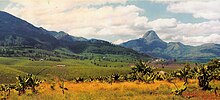Battle of Lioma
Led by George Giffard, the British forces almost managed to encircle and destroy the Schutztruppe, but in the end the Germans broke out and successfully retreated.
In this he was successful: While the German troops were able to forage food by plundering the countryside, the Schutztruppe defeated the Portuguese colonial and metropolitan forces several times, most notably during the Battle of Ngomano, thereby capturing large quantities of weapons, ammunition and medical supplies from the enemy.
With the Portuguese proving unable to defeat the German forces, the British had to bear the brunt of the fighting in Mozambique, and thus began to aggressively pursue Lettow-Vorbeck's small army.
[12] By August 1918, the Schutztruppe was heading north to return to German East Africa, while the British under Jacob van Deventer had begun to concentrate their forces in the area of Regone and Lioma in an attempt to encircle their enemy.
[7] Many African as well as European soldiers had deserted or surrendered as the allies overran their home areas in German East Africa, wages were no longer paid, and life in the army became harder and more brutal.
This was particularly problematic because the Schutztruppe's ability to continue to function as coherent, effective fighting force largely rested upon its experienced and capable leadership.
Even though they suffered from exhaustion, poor supplies, hunger, excessive heat or cold, and an increasingly experienced and stubborn opponent in form of the King's African Rifles during the fighting in Portuguese East Africa, these core cadres refused to give up – be it out of loyalty to their comrades, economic self-interest, desire for revenge,[18][19][20] or sheer will to survive.
[c] Battle-hardened, experienced in mobile bush-warfare, and possessed by a strong esprit de corps after years of warfare, they still constituted a force to be reckoned with.
[30] Willpower alone could not substitute for adequate supplies and reinforcements, however, so that the Schutztruppe's effective combat power had still much declined by 1918, and the Germans could no longer meet strong enemy formations head-on without risking their own destruction.
[37] Furthermore, the extremely poor quality or non-existence of roads in Mozambique greatly hindered the supply of the large numbers of KAR soldiers who chased the small Schutztruppe.
Despite these adverse conditions, the British native soldiers generally proved themselves to be tenacious and very capable fighters, motivated by a variety of reasons, most of them rooted in traditional African concepts of loyalty and their comparably high wages.
[42][43][37] The white and black officers and NCOs of the King's African Rifles also led by example and like their Schutztruppe counterparts suffered heavy losses, though unlike the Germans the British could relatively quickly replace them.
[38] Indeed, as the German columns (Abteilungen, short: Abt) advanced on the village, one of the relief units, namely 3/2nd KAR under Lt-Col Charles George Phillips, arrived around 12:00 and deployed north-east of 1/1st main position at Lioma.
When Lettow-Vorbeck learned of this firefight, he incorrectly assessed that the British had not yet fortified their positions due to the minimal defenses of the encountered forward outpost.
[37] One small German group actually succeeded in breaking into the northwestern corner of the British defensive square, but they were quickly killed.
[46][47] In course of the following night, Lettow-Vorbeck came to the conclusion that his forces had to escape Lioma toward the east; he knew that the Schutztruppe needed a respite and that more enemy units were converging on his position.
Lt-Col Giffard, who had arrived with 2/2nd KAR and now took command over all present British forces, consequently saw a good opportunity to finally encircle and crush the Schutztruppe.
[50] Other elements of the 2/2nd and 3/2nd KAR attempted to flank this vanguard and attack the German main body in order to scatter its carriers and capture its supplies, which would have meant a heavy logistical blow for the Schutztruppe.
After encountering 2/2nd and 3/2nd KAR, Lettow-Vorbeck initially assumed that he could possibly destroy them with a determined counter-attack using all his forces; this plan was dropped, however, when it became clear that the German main body had already too far advanced northwards to be called back for an assault.
Hindered in its advance only by a few snipers, 1/2nd KAR then moved into the northern hills, where the German main body and the remaining rearguard were located, and promptly came under machine gun fire.
This only briefly halted the King's African Rifles soldiers, and overall the German rearguard offered only light resistance to 1/2nd KAR until it was forced to retreat northwards in disorder around 15:00.
[50] Due to the difficult terrain, however, the communications between the retreating Schutztruppe forces had "become hopelessly muddled" and order had also largely broken down: The western vanguard units, attempting to climb the steep northern granite hills, had become lost, while the situation among the main body was also chaotic.
[55][26] The Germans had also failed in taking Lioma and thus could not replenish their supplies;[55] instead, they had lost 50,000 rounds of ammunition, crucial medical stores, and around 200 carriers, who had been scattered in course of the battle.
After Pere Hills, it travelled the remaining distance to German East Africa largely unopposed,[57] and would, albeit greatly reduced in strength and numbers, continue to stay in action until the end of the war.






